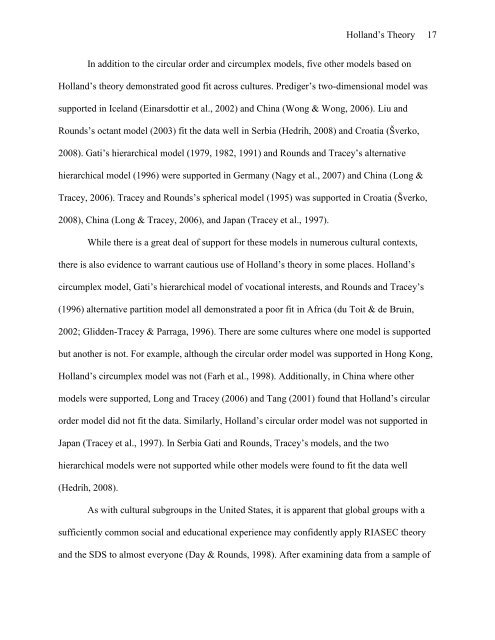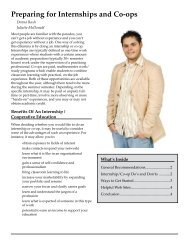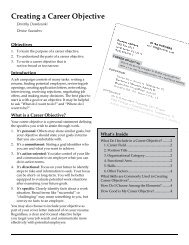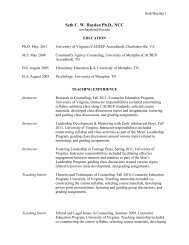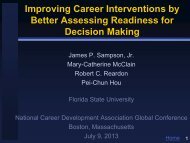Holland's Theory in a Post-Modern World: - The Career Center ...
Holland's Theory in a Post-Modern World: - The Career Center ...
Holland's Theory in a Post-Modern World: - The Career Center ...
You also want an ePaper? Increase the reach of your titles
YUMPU automatically turns print PDFs into web optimized ePapers that Google loves.
Holland’s <strong><strong>The</strong>ory</strong> 17In addition to the circular order and circumplex models, five other models based onHolland’s theory demonstrated good fit across cultures. Prediger’s two-dimensional model wassupported <strong>in</strong> Iceland (E<strong>in</strong>arsdottir et al., 2002) and Ch<strong>in</strong>a (Wong & Wong, 2006). Liu andRounds’s octant model (2003) fit the data well <strong>in</strong> Serbia (Hedrih, 2008) and Croatia (Šverko,2008). Gati’s hierarchical model (1979, 1982, 1991) and Rounds and Tracey’s alternativehierarchical model (1996) were supported <strong>in</strong> Germany (Nagy et al., 2007) and Ch<strong>in</strong>a (Long &Tracey, 2006). Tracey and Rounds’s spherical model (1995) was supported <strong>in</strong> Croatia (Šverko,2008), Ch<strong>in</strong>a (Long & Tracey, 2006), and Japan (Tracey et al., 1997).While there is a great deal of support for these models <strong>in</strong> numerous cultural contexts,there is also evidence to warrant cautious use of Holland’s theory <strong>in</strong> some places. Holland’scircumplex model, Gati’s hierarchical model of vocational <strong>in</strong>terests, and Rounds and Tracey’s(1996) alternative partition model all demonstrated a poor fit <strong>in</strong> Africa (du Toit & de Bru<strong>in</strong>,2002; Glidden-Tracey & Parraga, 1996). <strong>The</strong>re are some cultures where one model is supportedbut another is not. For example, although the circular order model was supported <strong>in</strong> Hong Kong,Holland’s circumplex model was not (Farh et al., 1998). Additionally, <strong>in</strong> Ch<strong>in</strong>a where othermodels were supported, Long and Tracey (2006) and Tang (2001) found that Holland’s circularorder model did not fit the data. Similarly, Holland’s circular order model was not supported <strong>in</strong>Japan (Tracey et al., 1997). In Serbia Gati and Rounds, Tracey’s models, and the twohierarchical models were not supported while other models were found to fit the data well(Hedrih, 2008).As with cultural subgroups <strong>in</strong> the United States, it is apparent that global groups with asufficiently common social and educational experience may confidently apply RIASEC theoryand the SDS to almost everyone (Day & Rounds, 1998). After exam<strong>in</strong><strong>in</strong>g data from a sample of


